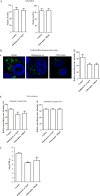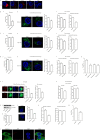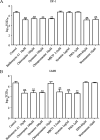Newcastle Disease Virus Entry into Chicken Macrophages via a pH-Dependent, Dynamin and Caveola-Mediated Endocytic Pathway That Requires Rab5
- PMID: 33762417
- PMCID: PMC8437353
- DOI: 10.1128/JVI.02288-20
Newcastle Disease Virus Entry into Chicken Macrophages via a pH-Dependent, Dynamin and Caveola-Mediated Endocytic Pathway That Requires Rab5
Abstract
The cellular entry pathways and the mechanisms of Newcastle disease virus (NDV) entry into cells are poorly characterized. In this study, we demonstrated that chicken interferon-induced transmembrane protein 1 (chIFITM1), which is located in the early endosomes, could limit the replication of NDV in chicken macrophage cell line HD11, suggesting the endocytic entry of NDV into chicken macrophages. Then, we presented a systematic study about the entry mechanism of NDV into chicken macrophages. First, we demonstrated that a low-pH condition and dynamin were required during NDV entry. However, NDV entry into chicken macrophages was independent of clathrin-mediated endocytosis. We also found that NDV entry was dependent on membrane cholesterol. The NDV entry and replication were significantly reduced by nystatin and phorbol 12-myristate 13-acetate treatment, overexpression of dominant-negative (DN) caveolin-1, or knockdown of caveolin-1, suggesting that NDV entry depends on caveola-mediated endocytosis. However, macropinocytosis did not play a role in NDV entry into chicken macrophages. In addition, we found that Rab5, rather than Rab7, was involved in the entry and traffic of NDV. The colocalization of NDV with Rab5 and early endosome suggested that NDV virion was transported to early endosomes in a Rab5-dependent manner after internalization. Of particular note, the caveola-mediated endocytosis was also utilized by NDV to enter primary chicken macrophages. Moreover, NDV entered different cell types using different pathways. Collectively, our findings demonstrate for the first time that NDV virion enters chicken macrophages via a pH-dependent, dynamin and caveola-mediated endocytosis pathway and that Rab5 is involved in the traffic and location of NDV. IMPORTANCE Although the pathogenesis of Newcastle disease virus (NDV) has been extensively studied, the detailed mechanism of NDV entry into host cells is largely unknown. Macrophages are the first-line defenders of host defense against infection of pathogens. Chicken macrophages are considered one of the main types of target cells during NDV infection. Here, we comprehensively investigated the entry mechanism of NDV in chicken macrophages. This is the first report to demonstrate that NDV enters chicken macrophages via a pH-dependent, dynamin and caveola-mediated endocytosis pathway that requires Rab5. The result is important for our understanding of the entry of NDV in chicken macrophages, which will further advance the knowledge of NDV pathogenesis and provide useful clues for the development of novel preventive or therapeutic strategies against NDV infection. In addition, this information will contribute to our further understanding of pathogenesis with regard to other members of the Avulavirus genus in the Paramyxoviridae family.
Keywords: Newcastle disease virus; Rab5; chicken macrophage; endocytic pathway.
Figures









Similar articles
-
Entry of Newcastle disease virus into host cells: an interplay among viral and host factors.Arch Virol. 2024 Oct 21;169(11):227. doi: 10.1007/s00705-024-06157-6. Arch Virol. 2024. PMID: 39428451 Review.
-
Entry of Classical Swine Fever Virus into PK-15 Cells via a pH-, Dynamin-, and Cholesterol-Dependent, Clathrin-Mediated Endocytic Pathway That Requires Rab5 and Rab7.J Virol. 2016 Sep 29;90(20):9194-208. doi: 10.1128/JVI.00688-16. Print 2016 Oct 15. J Virol. 2016. PMID: 27489278 Free PMC article.
-
Rab5 and Rab11 Are Required for Clathrin-Dependent Endocytosis of Japanese Encephalitis Virus in BHK-21 Cells.J Virol. 2017 Sep 12;91(19):e01113-17. doi: 10.1128/JVI.01113-17. Print 2017 Oct 1. J Virol. 2017. PMID: 28724764 Free PMC article.
-
Seneca Valley Virus Enters PK-15 Cells via Caveolae-Mediated Endocytosis and Macropinocytosis Dependent on Low-pH, Dynamin, Rab5, and Rab7.J Virol. 2022 Dec 21;96(24):e0144622. doi: 10.1128/jvi.01446-22. Epub 2022 Dec 6. J Virol. 2022. PMID: 36472440 Free PMC article.
-
Multifunctionality of matrix protein in the replication and pathogenesis of Newcastle disease virus: A review.Int J Biol Macromol. 2023 Sep 30;249:126089. doi: 10.1016/j.ijbiomac.2023.126089. Epub 2023 Jul 31. Int J Biol Macromol. 2023. PMID: 37532184 Review.
Cited by
-
Review of respiratory syndromes in poultry: pathogens, prevention, and control measures.Vet Res. 2025 May 17;56(1):101. doi: 10.1186/s13567-025-01506-y. Vet Res. 2025. PMID: 40382667 Free PMC article. Review.
-
Development and function of chicken XCR1+ conventional dendritic cells.Front Immunol. 2023 Oct 25;14:1273661. doi: 10.3389/fimmu.2023.1273661. eCollection 2023. Front Immunol. 2023. PMID: 37954617 Free PMC article.
-
Entry of Newcastle disease virus into host cells: an interplay among viral and host factors.Arch Virol. 2024 Oct 21;169(11):227. doi: 10.1007/s00705-024-06157-6. Arch Virol. 2024. PMID: 39428451 Review.
-
Chicken interferon-induced transmembrane protein 1 promotes replication of coronavirus infectious bronchitis virus in a cell-specific manner.Vet Microbiol. 2022 Dec;275:109597. doi: 10.1016/j.vetmic.2022.109597. Epub 2022 Oct 28. Vet Microbiol. 2022. PMID: 36368134 Free PMC article.
-
LINC08148 promotes the caveola-mediated endocytosis of Zika virus through upregulating transcription of Src.J Virol. 2024 Jun 13;98(6):e0170523. doi: 10.1128/jvi.01705-23. Epub 2024 May 14. J Virol. 2024. PMID: 38742902 Free PMC article.
References
-
- Alexander DJ. 2009. Ecology and epidemiology of Newcastle disease, p 19–26. In Capua I, Alexander DJ (ed), Avian influenza and Newcastle disease. Springer, New York, NY.
Publication types
MeSH terms
Substances
LinkOut - more resources
Full Text Sources
Other Literature Sources
Research Materials

